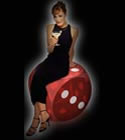General Strategy
In stud eight-or-better, it is difficult to predict when the raising will start, because on the later street, cards can come out that dramatically change hands.
As an example, low draws can pick up flush potential. Consequently, a reasonable strategy to pursue when the pot is still small – particularly on Fifth Street – is to get out any time that your hand does not appear to be the best hand for one way or the other.
This is especially true if there are hands out that are well-defined in each direction.
If you fail to fold in this situation, you may get trapped for a bigger bet and several raises on a later round.
The only exception to folding is when you have a two-way hand. In this case, it is usually worth chasing slightly better one-way hands.
Needless to say, if no one catches anything that appears to make his hand better, you may want to go further with your hand.
You also can go further if you are against players who tend not to jam unless they have a cinch hand.
Against more aggressive players who jam a lot, you need to be careful about getting too involved in the pot.
When you hold a good hand, you should be player who frequently jams. Your opponents will fear you, plus many players don’t like to put a lot of money into the pot.
So if you are a jamming type player, most opponents will be cautious when playing against you.
They swill check to you more, and you will be able to control the size of the pot and how you want to play your hand.
The fear factor is very important in this game ( as it is in most games ).
You want your opponents to fear you not because you always have a good hand, but because your hand is difficult to read and you are willing to put a lot of money in the pot. ( If your opponents always know you have a good hand, they will be able to define it and play accordingly.)
An extremely important skill is the ability to size up what it will cost you to see the hand through, since there are frequently many bets and raises on the later rounds.
In other games, it is usually easy to figure out what the hand will cost to go all the way.
But in this game, there can be many bets and raises, so you must have the ability to make a good estimate of how many more bets the hand is likely to cost.
Specifically, if you get into a spot where it looks as though you might get squeezed on a later round, be aware that this round might cost three or four bets instead of one.
Hence, instead of paying two or three bets to go to the river, as you would in most other games, it can easily end up costing you seven to ten bets. This means that your implied odds can change dramatically.
You might make a great deal of money if you draw out, but trying to do so may not be worth the price.
A related idea is that you can play further against players who don’t jam much and are reluctant to try to squeeze you out.
On the other hand, against very aggressive players who like to cap all the bets off, plus to raise and jam even in some of the more marginal situations, you will have to give up on your hand a lot sooner.
When you get trapped against this type of player and you hold a second-best hand that needs to draw out, it can be suicide.
Consequently, it is very important to accurately judge your opponents by how they play their hands.
Knowing whether some people playing tight games or playing loose games is not enough. You also must know how fast they play and how often they jam the pot.
Against those players who play very fast, you want to play two-way hands, hands that are well-disguised, and the bigger hands, because you will make much more money than normal.
Against players who are passive and conservative – and many players are this way – you can play a few more hands.
Following are a few general concepts for seven card stud eight-or-better. Many of these ideas will be discussed in more detail later in the text, but a quick overview of them here should be most helpful.
Concept No.1: One-way hands, especially heads up, go way down in value.
Let’s look at a simple calculation. Suppose on Fifth Street that there are two bets in the pot. You have a chance to win only half the pot, but you think it is likely that you will win that half.
Is a call correct It turns out that calling in this situation may be wrong. Since going to the end will cost you three bets, which you will forfeit if you get scooped, you need to win your half of the pot at least 75 percent of the time for your calls to be correct.
This is because you are risking three bets to win only one bet. Consequently, if you are not a big favorite to win your half of the pot, you should throw your hand away.
For example, suppose you hold and are facing throw your hand away. The only exception is when the pot is large. Here’s another example.










or





Introduction / General Strategy / How Far Do You Go? / Fourth Street / Check-Raising on Fourth and Fifth Streets / Fifth Street / Sixth Street / Seventh Street / Afterthought


